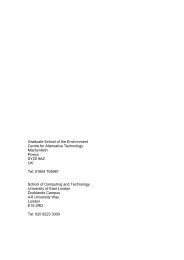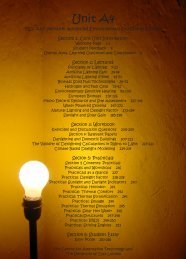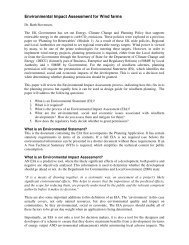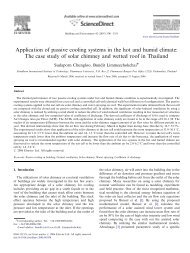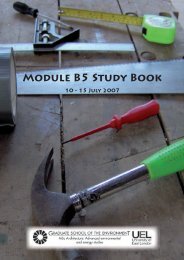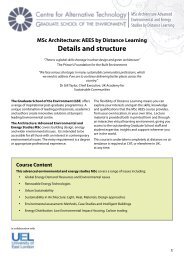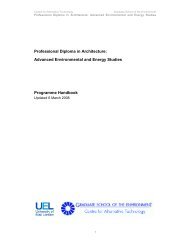Module B1 Study Book - the Graduate School of the Environment
Module B1 Study Book - the Graduate School of the Environment
Module B1 Study Book - the Graduate School of the Environment
Create successful ePaper yourself
Turn your PDF publications into a flip-book with our unique Google optimized e-Paper software.
Fridges and freezers<br />
EC Regulation on Substances That Deplete The Ozone Layer, which came<br />
into effect in October 2001, requires member states to remove ozone<br />
depleting substances (ODS) (including CFCs and HCFCs) from refrigeration<br />
equipment before such appliances are scrapped. This requirement came<br />
into force immediately for industrial and commercial appliances and applied<br />
to domestic appliances from 1 January 2002. It is estimated that up to 3<br />
million domestic refrigeration units are disposed <strong>of</strong> in <strong>the</strong> UK each year.<br />
Although <strong>the</strong>re is less data available, it is believed that around a fur<strong>the</strong>r<br />
half million commercial units are also replaced annually. ODS should be<br />
recovered for destruction, or for recycling or reclamation during <strong>the</strong> servicing<br />
and maintenance <strong>of</strong> equipment, or before <strong>the</strong> dismantling or final disposal<br />
<strong>of</strong> equipment. For fridges and freezers this applies to any ODS used as <strong>the</strong><br />
refrigerant and/or <strong>the</strong> blowing agent (in <strong>the</strong> insulation foam). As <strong>the</strong> insulation<br />
foam is integral to units specialised facilities to extract ODS from <strong>the</strong> foam<br />
are necessary.<br />
End <strong>of</strong> Life Vehicles (ELVs)<br />
The ELV Directive aims to reduce <strong>the</strong> amount <strong>of</strong> waste from vehicles when<br />
<strong>the</strong>y are finally scrapped. In particular, it includes:<br />
• tightened environmental standards for vehicle treatment sites<br />
• that last owners must be able to dispose <strong>of</strong> <strong>the</strong>ir vehicles free <strong>of</strong><br />
charge from 1 January 2007 (and requires producers to pay all or a<br />
significant part <strong>of</strong> <strong>the</strong> free take-back from this date),<br />
• sets rising reuse, recycling and recovery targets and<br />
• restricts <strong>the</strong> use <strong>of</strong> hazardous substances in both new vehicles and<br />
replacement vehicle parts.<br />
The UK has transposed <strong>the</strong> Directive through its ELV Regulations 2003 and<br />
2005. The 2003 Regulations put in place most <strong>of</strong> <strong>the</strong> requirements <strong>of</strong> <strong>the</strong><br />
Directive, including <strong>the</strong> improved standards for vehicle treatment sites, some<br />
new technical standards that apply to new vehicles and <strong>the</strong> establishment <strong>of</strong><br />
a Certificate <strong>of</strong> Destruction (CoD) system.<br />
The remaining provisions were <strong>the</strong> subject <strong>of</strong> <strong>the</strong> 2005 Regulations, which<br />
requires vehicle producers to have available networks <strong>of</strong> facilities where last<br />
owners <strong>of</strong> <strong>the</strong>ir brands <strong>of</strong> vehicles may take <strong>the</strong>m for treatment at <strong>the</strong> end <strong>of</strong><br />
<strong>the</strong>ir lives.<br />
Waste Electrical and Electronic Equipment (WEEE)<br />
The Waste Electrical and Electronic Equipment (WEEE) Directive was agreed<br />
on 13 February 2003, along with <strong>the</strong> related Directive on Restrictions <strong>of</strong> <strong>the</strong><br />
use <strong>of</strong> certain Hazardous Substances in electrical and electronic equipment<br />
(RoHS).<br />
The WEEE Directive aims to minimise <strong>the</strong> impacts <strong>of</strong> electrical and electronic<br />
equipment on <strong>the</strong> environment during <strong>the</strong>ir life times and when <strong>the</strong>y become<br />
waste. It applies to a huge spectrum <strong>of</strong> products. It encourages and sets<br />
72 Lecture: Waste policy




